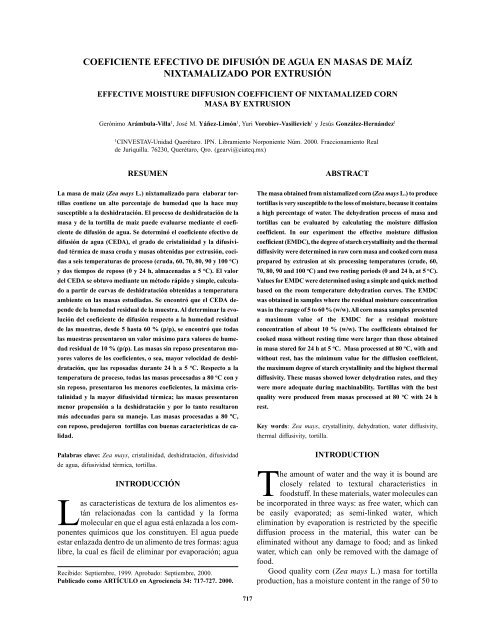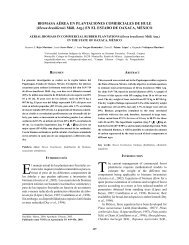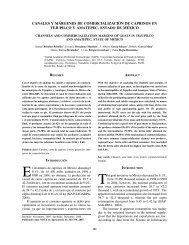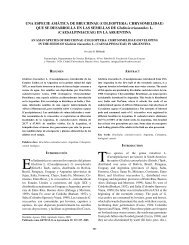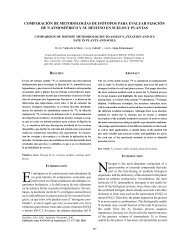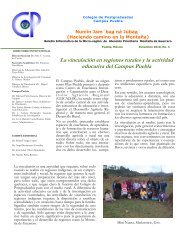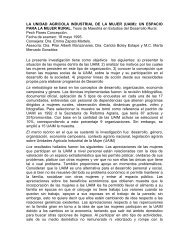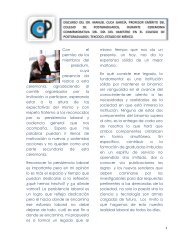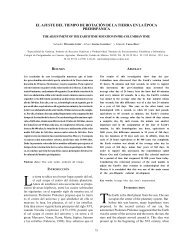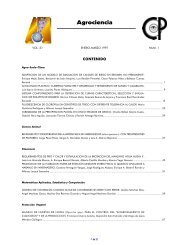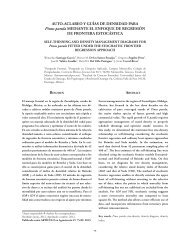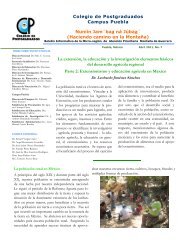Coeficiente efectivo de difusión de agua en masas de maíz ...
Coeficiente efectivo de difusión de agua en masas de maíz ...
Coeficiente efectivo de difusión de agua en masas de maíz ...
You also want an ePaper? Increase the reach of your titles
YUMPU automatically turns print PDFs into web optimized ePapers that Google loves.
COEFICIENTE EFECTIVO DE DIFUSIÓN DE AGUA EN MASAS DE MAÍZ<br />
NIXTAMALIZADO POR EXTRUSIÓN<br />
EFFECTIVE MOISTURE DIFFUSION COEFFICIENT OF NIXTAMALIZED CORN<br />
MASA BY EXTRUSION<br />
Gerónimo Arámbula-Villa 1 , José M. Yáñez-Limón 1 , Yuri Vorobiev-Vasilievich 1 y Jesús González-Hernán<strong>de</strong>z 1<br />
1 CINVESTAV-Unidad Querétaro. IPN. Librami<strong>en</strong>to Norponi<strong>en</strong>te Núm. 2000. Fraccionami<strong>en</strong>to Real<br />
<strong>de</strong> Juriquilla. 76230, Querétaro, Qro. (gearvi@ciateq.mx)<br />
RESUMEN<br />
La masa <strong>de</strong> <strong>maíz</strong> (Zea mays L.) nixtamalizado para elaborar tortillas<br />
conti<strong>en</strong>e un alto porc<strong>en</strong>taje <strong>de</strong> humedad que la hace muy<br />
susceptible a la <strong>de</strong>shidratación. El proceso <strong>de</strong> <strong>de</strong>shidratación <strong>de</strong> la<br />
masa y <strong>de</strong> la tortilla <strong>de</strong> <strong>maíz</strong> pue<strong>de</strong> evaluarse mediante el coefici<strong>en</strong>te<br />
<strong>de</strong> <strong>difusión</strong> <strong>de</strong> <strong>agua</strong>. Se <strong>de</strong>terminó el coefici<strong>en</strong>te <strong>efectivo</strong> <strong>de</strong><br />
<strong>difusión</strong> <strong>de</strong> <strong>agua</strong> (CEDA), el grado <strong>de</strong> cristalinidad y la difusividad<br />
térmica <strong>de</strong> masa cruda y <strong>masas</strong> obt<strong>en</strong>idas por extrusión, cocidas<br />
a seis temperaturas <strong>de</strong> proceso (cruda, 60, 70, 80, 90 y 100 oC) y dos tiempos <strong>de</strong> reposo (0 y 24 h, almac<strong>en</strong>adas a 5 oC). El valor<br />
<strong>de</strong>l CEDA se obtuvo mediante un método rápido y simple, calculado<br />
a partir <strong>de</strong> curvas <strong>de</strong> <strong>de</strong>shidratación obt<strong>en</strong>idas a temperatura<br />
ambi<strong>en</strong>te <strong>en</strong> las <strong>masas</strong> estudiadas. Se <strong>en</strong>contró que el CEDA <strong>de</strong>p<strong>en</strong><strong>de</strong><br />
<strong>de</strong> la humedad residual <strong>de</strong> la muestra. Al <strong>de</strong>terminar la evolución<br />
<strong>de</strong>l coefici<strong>en</strong>te <strong>de</strong> <strong>difusión</strong> respecto a la humedad residual<br />
<strong>de</strong> las muestras, <strong>de</strong>s<strong>de</strong> 5 hasta 60 % (p/p), se <strong>en</strong>contró que todas<br />
las muestras pres<strong>en</strong>taron un valor máximo para valores <strong>de</strong> humedad<br />
residual <strong>de</strong> 10 % (p/p). Las <strong>masas</strong> sin reposo pres<strong>en</strong>taron mayores<br />
valores <strong>de</strong> los coefici<strong>en</strong>tes, o sea, mayor velocidad <strong>de</strong> <strong>de</strong>shidratación,<br />
que las reposadas durante 24 h a 5 oC. Respecto a la<br />
temperatura <strong>de</strong> proceso, todas las <strong>masas</strong> procesadas a 80 oC con y<br />
sin reposo, pres<strong>en</strong>taron los m<strong>en</strong>ores coefici<strong>en</strong>tes, la máxima cristalinidad<br />
y la mayor difusividad térmica; las <strong>masas</strong> pres<strong>en</strong>taron<br />
m<strong>en</strong>or prop<strong>en</strong>sión a la <strong>de</strong>shidratación y por lo tanto resultaron<br />
más a<strong>de</strong>cuadas para su manejo. Las <strong>masas</strong> procesadas a 80 ºC,<br />
con reposo, produjeron tortillas con bu<strong>en</strong>as características <strong>de</strong> calidad.<br />
Palabras clave: Zea mays, cristalinidad, <strong>de</strong>shidratación, difusividad<br />
<strong>de</strong> <strong>agua</strong>, difusividad térmica, tortillas.<br />
INTRODUCCIÓN<br />
Las características <strong>de</strong> textura <strong>de</strong> los alim<strong>en</strong>tos están<br />
relacionadas con la cantidad y la forma<br />
molecular <strong>en</strong> que el <strong>agua</strong> está <strong>en</strong>lazada a los compon<strong>en</strong>tes<br />
químicos que los constituy<strong>en</strong>. El <strong>agua</strong> pue<strong>de</strong><br />
estar <strong>en</strong>lazada <strong>de</strong>ntro <strong>de</strong> un alim<strong>en</strong>to <strong>de</strong> tres formas: <strong>agua</strong><br />
libre, la cual es fácil <strong>de</strong> eliminar por evaporación; <strong>agua</strong><br />
Recibido: Septiembre, 1999. Aprobado: Septiembre, 2000.<br />
Publicado como ARTÍCULO <strong>en</strong> Agroci<strong>en</strong>cia 34: 717-727. 2000.<br />
717<br />
ABSTRACT<br />
The masa obtained from nixtamalized corn (Zea mays L.) to produce<br />
tortillas is very susceptible to the loss of moisture, because it contains<br />
a high perc<strong>en</strong>tage of water. The <strong>de</strong>hydration process of masa and<br />
tortillas can be evaluated by calculating the moisture diffusion<br />
coeffici<strong>en</strong>t. In our experim<strong>en</strong>t the effective moisture diffusion<br />
coeffici<strong>en</strong>t (EMDC), the <strong>de</strong>gree of starch crystallinity and the thermal<br />
diffusivity were <strong>de</strong>termined in raw corn masa and cooked corn masa<br />
prepared by extrusion at six processing temperatures (cru<strong>de</strong>, 60,<br />
70, 80, 90 and 100 oC) and two resting periods (0 and 24 h, at 5 oC). Values for EMDC were <strong>de</strong>termined using a simple and quick method<br />
based on the room temperature <strong>de</strong>hydration curves. The EMDC<br />
was obtained in samples where the residual moisture conc<strong>en</strong>tration<br />
was in the range of 5 to 60 % (w/w). All corn masa samples pres<strong>en</strong>ted<br />
a maximum value of the EMDC for a residual moisture<br />
conc<strong>en</strong>tration of about 10 % (w/w). The coeffici<strong>en</strong>ts obtained for<br />
cooked masa without resting time were larger than those obtained<br />
in masa stored for 24 h at 5 oC. Masa processed at 80 oC, with and<br />
without rest, has the minimum value for the diffusion coeffici<strong>en</strong>t,<br />
the maximum <strong>de</strong>gree of starch crystallinity and the highest thermal<br />
diffusivity. These <strong>masas</strong> showed lower <strong>de</strong>hydration rates, and they<br />
were more a<strong>de</strong>quate during machinability. Tortillas with the best<br />
quality were produced from <strong>masas</strong> processed at 80 oC with 24 h<br />
rest.<br />
Key words: Zea mays, crystallinity, <strong>de</strong>hydration, water diffusivity,<br />
thermal diffusivity, tortilla.<br />
INTRODUCTION<br />
The amount of water and the way it is bound are<br />
closely related to textural characteristics in<br />
foodstuff. In these materials, water molecules can<br />
be incorporated in three ways: as free water, which can<br />
be easily evaporated; as semi-linked water, which<br />
elimination by evaporation is restricted by the specific<br />
diffusion process in the material, this water can be<br />
eliminated without any damage to food; and as linked<br />
water, which can only be removed with the damage of<br />
food.<br />
Good quality corn (Zea mays L.) masa for tortilla<br />
production, has a moisture cont<strong>en</strong>t in the range of 50 to
718<br />
AGROCIENCIA VOLUMEN 34, NÚMERO 6, NOVIEMBRE-DICIEMBRE 2000<br />
semiligada, don<strong>de</strong> los f<strong>en</strong>óm<strong>en</strong>os <strong>de</strong> <strong>difusión</strong> son importantes<br />
y restring<strong>en</strong> su eliminación, pero cuando se logra<br />
eliminarla no hay <strong>de</strong>scomposición <strong>de</strong>l alim<strong>en</strong>to; y <strong>agua</strong><br />
ligada, la que para ser eliminada requiere <strong>de</strong>scomponer<br />
el alim<strong>en</strong>to.<br />
En una masa <strong>de</strong> <strong>maíz</strong> (Zea mays L.) <strong>de</strong> bu<strong>en</strong>a calidad<br />
para producir tortillas, la humedad <strong>de</strong>be oscilar <strong>en</strong>tre 50 y<br />
58 % (p/p); esta humedad es muy susceptible a disminuir<br />
a temperatura ambi<strong>en</strong>te. Al hacerlo, su textura se torna<br />
dura y difícil para darle forma <strong>de</strong> tortilla (disco aplanado),<br />
por lo que para un bu<strong>en</strong> troquelado <strong>de</strong> la masa es<br />
<strong>de</strong>seable que ésta ret<strong>en</strong>ga su humedad durante su manejo.<br />
La capacidad <strong>de</strong> ret<strong>en</strong>ción <strong>de</strong> <strong>agua</strong> <strong>de</strong> la masa <strong>de</strong> <strong>maíz</strong><br />
es afectada por los cambios bioquímicos provocados por<br />
la gelatinización <strong>de</strong> los gránulos <strong>de</strong> almidón y por las<br />
interacciones moleculares <strong>en</strong>tre éstos con las proteínas y<br />
con los lípidos que la constituy<strong>en</strong> (Bedolla y Rooney,<br />
1982). Los cambios físicos y químicos que se <strong>de</strong>tectan<br />
<strong>en</strong> la masa durante su procesami<strong>en</strong>to son el hinchami<strong>en</strong>to<br />
y ruptura <strong>de</strong> los gránulos <strong>de</strong> almidón, la pérdida <strong>de</strong><br />
cristalinidad y los efectos <strong>de</strong> retrogradación. La capacidad<br />
<strong>de</strong> ret<strong>en</strong>ción <strong>de</strong> <strong>agua</strong> <strong>en</strong> alim<strong>en</strong>tos se pue<strong>de</strong> evaluar<br />
mediante el coefici<strong>en</strong>te <strong>de</strong> <strong>difusión</strong> <strong>de</strong> <strong>agua</strong> (CDA), el<br />
cual es específico para cada material.<br />
La masa nixtamalizada, durante la <strong>de</strong>shidratación, es<br />
un sistema dinámico con una evolución estructural respecto<br />
al tiempo, cuyo comportami<strong>en</strong>to es el <strong>de</strong> un material<br />
granular y poroso, por lo que la pérdida <strong>de</strong> humedad<br />
<strong>de</strong>p<strong>en</strong><strong>de</strong> <strong>de</strong> la fracción volumétrica <strong>de</strong> porosidad, la que<br />
a su vez <strong>de</strong>p<strong>en</strong><strong>de</strong> <strong>de</strong>l cont<strong>en</strong>ido <strong>de</strong> humedad (Vag<strong>en</strong>as y<br />
Karathanos, 1991). Los cambios estructurales <strong>de</strong> la masa<br />
<strong>de</strong> <strong>maíz</strong> son importantes durante el cocimi<strong>en</strong>to <strong>de</strong> la tortilla<br />
ya que afectan su capacidad <strong>de</strong> trasmitir o ret<strong>en</strong>er el<br />
calor, y con ello los requerimi<strong>en</strong>tos <strong>en</strong>ergéticos para esta<br />
etapa <strong>en</strong> la producción <strong>de</strong> tortilla. A<strong>de</strong>más, la calidad <strong>de</strong><br />
la tortilla cocida <strong>de</strong>p<strong>en</strong><strong>de</strong> <strong>de</strong>l control <strong>de</strong> estos parámetros<br />
durante su procesami<strong>en</strong>to.<br />
Se han propuesto algunos métodos para <strong>de</strong>terminar<br />
el CDA para materiales alim<strong>en</strong>ticios granulares (Hanson<br />
et al., 1971; Yakubu et al., 1990; Vag<strong>en</strong>as y Karathanos,<br />
1991). Sin embargo, estos métodos se basan <strong>en</strong> el análisis<br />
teórico <strong>de</strong>l proceso <strong>de</strong> <strong>difusión</strong> y las ecuaciones que<br />
resultan incluy<strong>en</strong> parámetros <strong>de</strong> ajuste característicos <strong>de</strong><br />
cada alim<strong>en</strong>to (Vag<strong>en</strong>as y Karathanos, 1991). A<strong>de</strong>más,<br />
los cálculos <strong>de</strong> los coefici<strong>en</strong>tes son complicados y laboriosos,<br />
y sólo pue<strong>de</strong>n <strong>de</strong>terminarse cuando se conoc<strong>en</strong><br />
parámetros como la porosidad y las constantes <strong>de</strong> <strong>difusión</strong><br />
<strong>de</strong>l material, <strong>en</strong>tre otros.<br />
En este trabajo se <strong>de</strong>terminó la evolución <strong>de</strong>l coefici<strong>en</strong>te<br />
<strong>efectivo</strong> <strong>de</strong> <strong>difusión</strong> <strong>de</strong> <strong>agua</strong> (CEDA) <strong>en</strong> función <strong>de</strong>l<br />
cont<strong>en</strong>ido <strong>de</strong> humedad <strong>en</strong> <strong>masas</strong> <strong>de</strong> <strong>maíz</strong> producidas por<br />
extrusión a varias temperaturas. El CEDA se obtuvo mediante<br />
un método s<strong>en</strong>cillo y rápido reportado por Arámbula<br />
et al. (1999), el cual se basa <strong>en</strong> un análisis f<strong>en</strong>om<strong>en</strong>ológico<br />
<strong>de</strong>l proceso <strong>de</strong> <strong>difusión</strong> y utiliza únicam<strong>en</strong>te las curvas <strong>de</strong><br />
58 % (w/w). Nevertheless, masa is highly susceptible to<br />
the loss of moisture wh<strong>en</strong> it is stored at room<br />
temperature, making its texture hard and difficult to<br />
shape into round flat form for tortilla manufacturing.<br />
For a good handling of masa, it needs to retain the<br />
moistness during the mixing step.<br />
The water ret<strong>en</strong>tion capacity of corn masa is affected<br />
by the biochemical changes which are produced by the<br />
gelatinization of starch granules and the interactions<br />
betwe<strong>en</strong> those and the proteins and lipids of the masa<br />
(Bedolla and Rooney, 1982). The swelling and disruption<br />
of starch granules, the losing of crystallinity and the<br />
retrogradation effects are the chemical and physical<br />
changes of masa during its processing. The water ret<strong>en</strong>tion<br />
capacity in foods can be evaluated by the moisture<br />
diffusion coeffici<strong>en</strong>t (MDC), which is specific for each<br />
material.<br />
The <strong>de</strong>hydration of fresh nixtamalized masa is a<br />
dynamic process, with a structural evolution in time as<br />
in a granular and porous material, therefore, the loss of<br />
moisture <strong>de</strong>p<strong>en</strong>ds on the volume fraction of porosity<br />
which in turn <strong>de</strong>p<strong>en</strong>ds on the moisture cont<strong>en</strong>t (Vag<strong>en</strong>as<br />
and Karathanos, 1991). The structural changes of corn<br />
masa are important during tortilla cooking because they<br />
affect the heat transport or heat ret<strong>en</strong>tion capacity. The<br />
last parameters affect the <strong>en</strong>ergetic requirem<strong>en</strong>ts during<br />
the cooking of tortilla. The quality of tortilla <strong>de</strong>p<strong>en</strong>ds<br />
on the control of the above parameters during<br />
processing.<br />
Several methods have be<strong>en</strong> proposed to <strong>de</strong>termine the<br />
MDC in granular food materials (Hanson et al., 1971;<br />
Yakubu et al., 1990; Vag<strong>en</strong>as and Karathanos, 1991).<br />
However, the methods based on the theoretical analysis<br />
of the diffusion process use the corresponding diffusion<br />
equations with constant coeffici<strong>en</strong>ts in the equation and<br />
parameters adjusted which are specifics of each food<br />
(Vag<strong>en</strong>as and Karathanos, 1991). In addition, the<br />
calculations involved are complicated and tedious, and<br />
only can be used wh<strong>en</strong> the diffusion constants and the<br />
porosity values are known.<br />
In this work, the evolution of the effective moisture<br />
diffusion coeffici<strong>en</strong>t (EMDC) as a function of the<br />
residual moisture cont<strong>en</strong>t (RMC) of corn <strong>masas</strong><br />
produced by extrusion at various temperatures was<br />
<strong>de</strong>termined. The EMDC was obtained using a quick and<br />
simple method reported by Arámbula et al. (1999). This<br />
method is based on the analysis of the room temperature<br />
<strong>de</strong>hydration curves for fresh masa and a<br />
ph<strong>en</strong>om<strong>en</strong>ological solution of the diffusion process. The<br />
EMDC was correlated with the crystallinity and the<br />
thermal diffusivity. These measurem<strong>en</strong>ts give<br />
information about the gelatinization <strong>de</strong>gree and physical<br />
structure of starch foods (Zobel, 1988; Alvarado et al.,<br />
1995; Rodríguez et al., 1995; Yáñez-Limón et al.,<br />
1995).
ARÁMBULA-VILLA ET AL.: DIFUSIÓN DE AGUA EN MAÍZ NIXTAMALIZADO 719<br />
<strong>de</strong>shidratación a temperatura ambi<strong>en</strong>te. El CEDA fue<br />
correlacionado con la cristalinidad y la difusividad térmica<br />
<strong>de</strong>l material, pues estos dos parámetros proporcionan<br />
información acerca <strong>de</strong>l grado <strong>de</strong> gelatinización <strong>de</strong>l almidón<br />
y <strong>de</strong> la estructura física <strong>de</strong>l alim<strong>en</strong>to (Zobel, 1988;<br />
Alvarado et al., 1995; Rodríguez et al., 1995; Yañez-Limón<br />
et al., 1995).<br />
MATERIALES Y MÉTODOS<br />
Las <strong>masas</strong> se prepararon con <strong>maíz</strong> blanco comercial (ASPROS<br />
AS-910) cuyas características físicas fueron: peso <strong>de</strong> grano: 69.73±1.0<br />
kg/hL (método 55-10; AACC, 1995); índice <strong>de</strong> perlado (Salinas et al.,<br />
1992): 46.18±0.1 %, peso <strong>de</strong> 100 granos: 20.5±1.98 g; cal hidratada <strong>en</strong><br />
polvo (El topo, Monterrey, N. L., México) y <strong>agua</strong> electropura comercial.<br />
Preparación <strong>de</strong> las <strong>masas</strong><br />
Para preparar las muestras <strong>de</strong> <strong>masas</strong> cocidas se utilizó un extrusor<br />
continuo <strong>de</strong> bajo cizallami<strong>en</strong>to (Talleres García S. A., Monterrey,<br />
N. L., México), diseñado especialm<strong>en</strong>te para la producción <strong>de</strong> masa<br />
y harina instantánea <strong>de</strong> <strong>maíz</strong>, pat<strong>en</strong>tado por Martínez-Bustos et al.<br />
(1996). Como materia prima se utilizó harina integral <strong>de</strong> <strong>maíz</strong> crudo<br />
(tamaño medio <strong>de</strong> partícula, 177 µm), <strong>agua</strong> y cal [Ca(OH) 2 ],<br />
todos mezclados <strong>en</strong> una batidora (Kitch<strong>en</strong> Aid SS1). El equipo<br />
extrusor se alim<strong>en</strong>tó con una mezcla <strong>de</strong> 1 kg <strong>de</strong> harina <strong>de</strong> <strong>maíz</strong><br />
crudo, 0.735 L <strong>de</strong> <strong>agua</strong> y 3.0 g <strong>de</strong> cal. Las muestras se obtuvieron<br />
utilizando un tiempo <strong>de</strong> resi<strong>de</strong>ncia <strong>en</strong> el extrusor <strong>de</strong> 1.3 min, velocidad<br />
<strong>de</strong> tornillo <strong>de</strong> 25 rpm y cinco temperaturas <strong>de</strong> proceso (60,<br />
70, 80, 90 y 100 oC). La temperatura adicional <strong>de</strong> 25 oC (mezcla<br />
cruda) se utilizó como refer<strong>en</strong>cia. Una parte <strong>de</strong> la masa obt<strong>en</strong>ida<br />
directam<strong>en</strong>te <strong>de</strong>l extrusor se analizó <strong>de</strong> inmediato (sin reposo) y el<br />
resto se almac<strong>en</strong>ó <strong>en</strong> bolsas <strong>de</strong> polietil<strong>en</strong>o selladas <strong>en</strong> refrigeración<br />
a 5 oC (con reposo), para analizarlas 24 horas <strong>de</strong>spués. En este caso,<br />
como refer<strong>en</strong>cia se utilizó masa <strong>de</strong> <strong>maíz</strong> producida por el proceso<br />
tradicional <strong>de</strong> nixtamalización (Serna-Saldivar et al., 1990).<br />
Curvas <strong>de</strong> <strong>de</strong>shidratación<br />
Muestras <strong>de</strong> masa <strong>de</strong> 1.7±0.01 g se formatearon <strong>en</strong> forma <strong>de</strong> discos<br />
aplanados pequeños con un espesor <strong>de</strong> 1.27±0.01 mm y 37.25±0.1<br />
mm <strong>de</strong> diámetro. Estas muestras se colocaron sobre una malla <strong>de</strong> alambre,<br />
montada sobre una estructura, la cual se introdujo <strong>en</strong> la cámara <strong>de</strong><br />
una balanza analítica. La malla <strong>de</strong> alambre se utilizó para permitir que<br />
el <strong>agua</strong> <strong>de</strong> las muestras, con forma <strong>de</strong> tortillas, se evaporara por ambas<br />
caras. En el interior <strong>de</strong> la cámara <strong>de</strong> la balanza se colocó Ca(CO) 2 para<br />
eliminar el exceso <strong>de</strong> humedad ambi<strong>en</strong>te. Mediante una computadora<br />
se registró la pérdida <strong>de</strong> peso <strong>de</strong> la muestra <strong>en</strong> función <strong>de</strong>l tiempo<br />
hasta obt<strong>en</strong>er peso constante.<br />
Determinación <strong>de</strong>l coefici<strong>en</strong>te <strong>efectivo</strong> <strong>de</strong><br />
<strong>difusión</strong> <strong>de</strong> <strong>agua</strong> (CEDA)<br />
Se utilizó el método <strong>de</strong> Arámbula et al. (1999), que se basa <strong>en</strong> las<br />
sigui<strong>en</strong>tes consi<strong>de</strong>raciones:<br />
MATERIALS AND METHODS<br />
Commercial samples of food gra<strong>de</strong> white corn (ASPROS AS-910),<br />
lime (El topo, Monterrey, N. L., México) and water was used for tortilla<br />
production. Physical characteristics of corn grain were: test weight:<br />
69±1.0 kg/hL (55-10 method; AACC, 1995); pearled in<strong>de</strong>x (Salinas et<br />
al., 1992): 46.18±0.1 % and one hundred kernel weight: 20.5±1.98 g.<br />
Preparation of masa samples<br />
A continuous low shear extru<strong>de</strong>r (Talleres García S. A.,<br />
Monterrey N. L., México), <strong>de</strong>signed specially for producing fresh<br />
corn masa and instant corn flour, pat<strong>en</strong>ted by Martínez-Bustos et al.<br />
(1996) was used to prepared the samples. Whole raw corn flour<br />
(average particle size, 177 µm), water and lime [Ca(OH) 2 ] were mixed<br />
in a domestic bl<strong>en</strong><strong>de</strong>r (Kitch<strong>en</strong> Aid SS1) and used as raw materials.<br />
A mixture of 1 kg of raw corn flour, 0.735 L of water and 3.0 g of<br />
lime was feed to the extru<strong>de</strong>r. A resi<strong>de</strong>nce time of 1.3 min, screw<br />
speed at 25 rpm and five processing temperatures (60, 70, 80, 90 and<br />
100 oC) were used to obtain the differ<strong>en</strong>t samples. The temperature<br />
of 25 oC (cru<strong>de</strong>) was used as refer<strong>en</strong>ce. Part of the masa samples<br />
was analyzed immediately after elaboration (without storage) and<br />
others were stored at 5 oC in sealed polyethyl<strong>en</strong>e bags and analyzed<br />
24 h later (with storage). Tortillas samples produced by the traditional<br />
nixtamalization process (Serna-Saldivar et al., 1990) were used as<br />
refer<strong>en</strong>ces.<br />
Dehydration curves<br />
Masa samples of 1.7±0.01 g were shaped in flat disc form of<br />
1.27±0.01 mm thickness and 37.2 5±0.1 mm diameter. The sample<br />
was placed onto a structure that contained a metal scre<strong>en</strong> in the chamber<br />
of a analytical balance. The later allowed moisture evaporation through<br />
both surfaces of the masa sample. The <strong>de</strong>hydrate ag<strong>en</strong>t Ca(CO) 2 was<br />
placed into the balance chamber to remove the excess moisture. The<br />
weight loss due to <strong>de</strong>hydration was computer as a function of time<br />
until the weight reached constant value.<br />
Determination of effective moisture<br />
diffusion coeffici<strong>en</strong>t (EMDC)<br />
The Arámbula et al. (1999) method was used to <strong>de</strong>termine this<br />
parameter. This method assumes that:<br />
1. The sample diameter is larger than its thickness.<br />
2. The water loss due to the <strong>de</strong>hydration process (∆Pexp ) must<br />
occur by evaporation through both surfaces of sample, that<br />
t<br />
is: ∆Pexp = 2µ<br />
gSjdt, where µ = Mass of the water molecules (g),<br />
0<br />
g = The gravitational acceleration (m s-2 ), S = Area of both surfaces<br />
of masa samples where the evaporation occur (cm2 ), j = Evaporation<br />
ratio per unit surface (number of particles t –1 cm-2 ) and t = The<br />
<strong>de</strong>hydration time (s).<br />
Un<strong>de</strong>r this assumption:
720<br />
AGROCIENCIA VOLUMEN 34, NÚMERO 6, NOVIEMBRE-DICIEMBRE 2000<br />
1. El diámetro <strong>de</strong> la muestra es mayor que el espesor.<br />
2. La pérdida <strong>de</strong> <strong>agua</strong> por efectos <strong>de</strong> <strong>de</strong>shidratación (∆Pexp ) se<br />
lleva a cabo por evaporación <strong>de</strong>l <strong>agua</strong> a través <strong>de</strong> las dos superficies o<br />
t<br />
caras <strong>de</strong> la muestra, esto es: ∆Pexp = 2µ<br />
gSjdt, don<strong>de</strong> µ = Masa <strong>de</strong><br />
0<br />
las moléculas <strong>de</strong> <strong>agua</strong> (g), g = Aceleración <strong>de</strong> la gravedad (m s-2 ),<br />
S = Área <strong>de</strong> las caras por don<strong>de</strong> ocurre la evaporación (cm2 ), j =<br />
Razón <strong>de</strong> evaporación por unidad <strong>de</strong> superficie (número <strong>de</strong> partículas<br />
t-1 cm2 ) y t = El tiempo <strong>de</strong> <strong>de</strong>shidratación (s).<br />
Bajo estas consi<strong>de</strong>raciones:<br />
d∆Pexp =2µ gSj<br />
(1)<br />
dt<br />
3. La razón <strong>de</strong> evaporación j <strong>en</strong> condiciones experim<strong>en</strong>tales <strong>de</strong><br />
quasi-equilibrio (baja evaporación) es igual al flujo <strong>de</strong> <strong>agua</strong> difundida<br />
<strong>de</strong>s<strong>de</strong> el interior <strong>de</strong> la muestra a la superficie <strong>de</strong> la misma, esto es:<br />
j D dn<br />
=− , don<strong>de</strong> D es el coefici<strong>en</strong>te <strong>de</strong> <strong>difusión</strong>.<br />
dx<br />
4. En las condiciones <strong>de</strong> quasi-equilibrio no existe almac<strong>en</strong>ami<strong>en</strong>to<br />
<strong>de</strong> <strong>agua</strong> libre <strong>en</strong> el interior <strong>de</strong> la muestra. Esto significa que j no <strong>de</strong>p<strong>en</strong><strong>de</strong><br />
<strong>de</strong> “x”. Si se supone que D es constante <strong>en</strong> un tiempo dado, se<br />
pue<strong>de</strong> <strong>de</strong>finir un coefici<strong>en</strong>te <strong>efectivo</strong> <strong>de</strong> <strong>difusión</strong>, D= D′:<br />
D′ =<br />
dn<br />
constante (2)<br />
dx<br />
lo que significa que <strong>en</strong> cualquier tiempo, n(x) es una función lineal<br />
cuyo valor pue<strong>de</strong> ser estimado como:<br />
dn n<br />
=<br />
dx l<br />
2 0<br />
don<strong>de</strong> n0 es la conc<strong>en</strong>tración <strong>de</strong> <strong>agua</strong> <strong>en</strong> la muestra y l el espesor <strong>de</strong> la<br />
muestra.<br />
Hasta este punto se ha supuesto que la conc<strong>en</strong>tración <strong>de</strong> humedad<br />
<strong>en</strong> el ambi<strong>en</strong>te es <strong>de</strong>spreciable comparada con n0 ; si éste no fuera el<br />
caso, se introduce la difer<strong>en</strong>cia <strong>en</strong>tre la humedad n0 y la humedad ambi<strong>en</strong>te<br />
<strong>en</strong> la Ecuación 3; esta corrección se hace <strong>en</strong> la expresión final.<br />
d∆Pexp D gSn t<br />
5. Al sustituir (3) y (2) <strong>en</strong> (1), se obti<strong>en</strong>e: =<br />
,<br />
dt l<br />
′ 4 µ 0<br />
µgn t P t<br />
como = , la expresión final para D ′ es:<br />
Sl<br />
0<br />
2<br />
D′= 2<br />
ld∆Pexp t<br />
8Ptdt<br />
La conc<strong>en</strong>tración <strong>de</strong> humedad residual (HR) a cualquier tiempo<br />
<strong>de</strong> <strong>de</strong>shidratación dado (t) se <strong>de</strong>terminó restando la pérdida <strong>de</strong> peso al<br />
tiempo t <strong>de</strong> la pérdida <strong>de</strong> peso total y dividi<strong>en</strong>do esta difer<strong>en</strong>cia <strong>en</strong>tre<br />
el peso <strong>de</strong> la muestra al final <strong>de</strong> la <strong>de</strong>shidratación. De acuerdo con esta<br />
<br />
(3)<br />
(4)<br />
d∆Pexp =2µ gSj<br />
(1)<br />
dt<br />
3. The evaporation rate <strong>de</strong>nsity j in the experim<strong>en</strong>tal quasiequilibrium<br />
conditions (low evaporation) is equal to the diffusion water<br />
flux diffused from insi<strong>de</strong> to the sample surface, that is: j D dn<br />
=− ,<br />
dx<br />
where D is the diffusion coeffici<strong>en</strong>t.<br />
4. Un<strong>de</strong>r the above m<strong>en</strong>tioned quasi-equilibrium conditions no<br />
storing of free water insi<strong>de</strong> the samples exist. This means that j does<br />
not <strong>de</strong>p<strong>en</strong>d on “x”. If we assume that D at any giv<strong>en</strong> time is constant,<br />
the effective diffusion coeffici<strong>en</strong>t can be <strong>de</strong>fined, D= D′:<br />
D′ =<br />
dn<br />
constant (2)<br />
dx<br />
which means that at any time, n(x) is a linear function and its value<br />
could be estimated as:<br />
dn n<br />
=<br />
dx l<br />
2 0<br />
n0 being the water conc<strong>en</strong>tration in the sample and l is the sample<br />
thickness.<br />
Here, we also assumed that the moisture conc<strong>en</strong>tration in the<br />
ambi<strong>en</strong>t atmosphere is negligible compared to n0. If this is not the<br />
case, we introduce the differ<strong>en</strong>ce betwe<strong>en</strong> the n0 and the ambi<strong>en</strong>t<br />
moisture conc<strong>en</strong>tration in Equation 3; the corresponding correction<br />
will <strong>en</strong>ter in the final expression.<br />
5. Having introduced Equations 3 and 2 into 1, we obtain:<br />
d∆Pexp D gSn t<br />
=<br />
,<br />
dt l<br />
′ 4 µ 0<br />
µgn0 t P t<br />
since = , a final expression<br />
2 Sl<br />
for D′ is obtained:<br />
D′= 2<br />
ld∆Pexp t<br />
8Ptdt<br />
The residual moisture cont<strong>en</strong>t (RMC) at a giv<strong>en</strong> <strong>de</strong>hydration time<br />
(t) was <strong>de</strong>termined by subtracting the weight loss at the time t from the<br />
total weight loss and th<strong>en</strong> dividing that differ<strong>en</strong>ce by the total weight of<br />
the sample after the <strong>de</strong>hydration experim<strong>en</strong>t. According to our <strong>de</strong>finition,<br />
the RMC in the samples is not the absolute water cont<strong>en</strong>t, but rather it is<br />
the moisture conc<strong>en</strong>tration having as the zero refer<strong>en</strong>ce the equilibrium<br />
moisture conc<strong>en</strong>tration at room temperature (25 oC). Therefore, the<br />
EMDC can be obtained, which is a way to evaluate the <strong>de</strong>hydration rate<br />
of the food. Food with high EMDC are easily <strong>de</strong>hydrated.<br />
<br />
X-ray diffraction<br />
The spectra were tak<strong>en</strong> on dried pow<strong>de</strong>red samples of extru<strong>de</strong>d<br />
<strong>masas</strong>. The <strong>masas</strong> were dried in an ov<strong>en</strong> at vacuum conditions (Lab<br />
(3)<br />
(4)
ARÁMBULA-VILLA ET AL.: DIFUSIÓN DE AGUA EN MAÍZ NIXTAMALIZADO 721<br />
<strong>de</strong>finición, la HR no es el cont<strong>en</strong>ido real <strong>de</strong> <strong>agua</strong> <strong>en</strong> la muestra, sino es<br />
la conc<strong>en</strong>tración <strong>de</strong> <strong>agua</strong> tomando como refer<strong>en</strong>cia (o sea, humedad<br />
cero) la conc<strong>en</strong>tración <strong>de</strong> humedad <strong>en</strong> el equilibrio a temperatura<br />
ambi<strong>en</strong>te (25 oC). Con base <strong>en</strong> lo anterior, se pue<strong>de</strong> obt<strong>en</strong>er el CEDA<br />
que es una forma <strong>de</strong> evaluar la velocidad <strong>de</strong> <strong>de</strong>shidratación <strong>de</strong> un alim<strong>en</strong>to;<br />
a mayor valor <strong>de</strong> CEDA, mayor velocidad <strong>de</strong> <strong>de</strong>shidratación<br />
<strong>de</strong>l material.<br />
Difracción <strong>de</strong> rayos-X<br />
Esto se obtuvo <strong>en</strong> muestras <strong>de</strong> masa <strong>de</strong>shidratada y pulverizadas.<br />
Las <strong>masas</strong> se <strong>de</strong>shidrataron <strong>en</strong> una estufa al vacío (Lab Line, Mod.<br />
360-5) y se pulverizaron <strong>en</strong> un mortero hasta que pasaron la Malla 60<br />
(Mont-Inox., USA). Se utilizó un difractómetro Philips operando a 35<br />
KV con radiación <strong>de</strong> Cu Kα. Los difractogramas se obtuvieron <strong>de</strong>s<strong>de</strong><br />
2o hasta 60o <strong>en</strong> la escala 2θ. El porc<strong>en</strong>taje <strong>de</strong> cristalinidad se obtuvo al<br />
dividir el área bajo las líneas <strong>de</strong> difracción cristalinas (las más angostas)<br />
<strong>en</strong>tre el área total. Esta última incluye la difracción cristalina y la<br />
difracción no coher<strong>en</strong>te, la cual es originada por las estructuras<br />
moleculares más <strong>de</strong>sor<strong>de</strong>nadas.<br />
Mediciones <strong>de</strong> difusividad térmica<br />
La difusividad térmica se <strong>de</strong>terminó mediante el método<br />
fotoacústico (FA). En la Figura 1 se muestra <strong>en</strong> forma esquemática el<br />
arreglo experim<strong>en</strong>tal utilizado. Como fu<strong>en</strong>te <strong>de</strong> luz se utilizó una lámpara<br />
<strong>de</strong> x<strong>en</strong>ón <strong>de</strong> 250 Watts; el haz <strong>de</strong> luz policromática se modula<br />
mecánicam<strong>en</strong>te y se <strong>en</strong>foca hacia la muestra, la cual hace las veces <strong>de</strong><br />
una segunda v<strong>en</strong>tana cerrando la celda FA. La muestra <strong>en</strong> forma <strong>de</strong><br />
disco se sosti<strong>en</strong>e <strong>en</strong> un anillo <strong>de</strong> acrílico <strong>de</strong> 440 µm <strong>de</strong> altura y 9 mm<br />
<strong>de</strong> diámetro interno. Un lado <strong>de</strong> la abertura se tapa con una hoja <strong>de</strong><br />
aluminio <strong>de</strong> 50 µm <strong>de</strong> espesor sujeta al anillo <strong>de</strong> acrílico. El <strong>en</strong>vés <strong>de</strong><br />
la hoja <strong>de</strong> aluminio está <strong>en</strong> contacto con el aire externo y expuesto a la<br />
iluminación <strong>de</strong>l haz <strong>de</strong> luz. En una <strong>de</strong> las pare<strong>de</strong>s <strong>de</strong> la celda FA está<br />
montado un micrófono <strong>de</strong> electreto que queda <strong>en</strong> contacto con el aire<br />
<strong>de</strong>l lado interno <strong>de</strong> la cámara por medio <strong>de</strong> un conducto <strong>de</strong> 1 mm <strong>de</strong><br />
Tornillo<br />
Anillo <strong>de</strong><br />
acrílico<br />
Muestra<br />
V<strong>en</strong>tana<br />
<strong>de</strong> vidrio<br />
Espejo<br />
Hoja <strong>de</strong><br />
aluminio<br />
Modulador<br />
Cuerpo <strong>de</strong><br />
la celda<br />
Micrófono<br />
Fu<strong>en</strong>te<br />
<strong>de</strong> luz<br />
Figura 1. Esquema <strong>de</strong>l equipo <strong>de</strong> fotoacústica para medir difusividad<br />
térmica <strong>en</strong> <strong>masas</strong> <strong>de</strong> <strong>maíz</strong>.<br />
Figure 1. Schematic arrangem<strong>en</strong>t of the photoacoustic set up to<br />
measure the thermal diffusivity of masa samples.<br />
Line, Mod. 360-5) and pow<strong>de</strong>red in a morter until the pow<strong>de</strong>r could<br />
pass through the Mesh 60 (Mont-Inox, USA). The x-ray data was<br />
obtained using a Philips diffractometer, operating at 35 KV with the Cu<br />
Kα radiation. The diffractograms were obtained in the range of 2 to 60o in the 2θ scale. The perc<strong>en</strong>tage of crystallinity was calculated as the<br />
ratio of the area un<strong>de</strong>r the crystalline diffraction lines (the sharper ones)<br />
to the total area. The latter inclu<strong>de</strong>s both the crystalline diffraction and<br />
the non-coher<strong>en</strong>t radiation caused by the disor<strong>de</strong>red molecular structures.<br />
Measurem<strong>en</strong>ts of thermal diffusivity<br />
Thermal diffusivity was <strong>de</strong>termined using the photoacoustic (PA)<br />
method. The scheme of the experim<strong>en</strong>tal equipm<strong>en</strong>t used is shown in<br />
Figure 1. A x<strong>en</strong>on 250 Watts lamp was used as the light source; its<br />
polychromatic radiation was mechanically modulated and focused onto<br />
a sample serving as the second window of the PA cell. The sample shaped<br />
in disc form was positioned at the acrylic ring 440 µm thick with the<br />
internal diameter 9 mm. The sample was covered with a 50 µm thick<br />
aluminum sheet, which is in thermal contact with external air and exposed<br />
to the illumination. An electret microphone was mounted on one of the<br />
walls of the PA cell, the contact with the internal air was provi<strong>de</strong>d through<br />
a small hole, 1 mm in diameter. The signal g<strong>en</strong>erated by the microphone<br />
was analyzed by the “lock-in” amplifier able to register both the signal<br />
amplitu<strong>de</strong> and its phase <strong>de</strong>p<strong>en</strong>ding on the modulation frequ<strong>en</strong>cy. The<br />
arrangem<strong>en</strong>t <strong>de</strong>scribed corresponds to the configuration of the heat<br />
transmission, where the heat g<strong>en</strong>erated at the sample surface (due to the<br />
light-to-heat conversion by the covering Al sheet) diffuses through the<br />
sample and reaches the PA cell causing pressure variations in the air<br />
insi<strong>de</strong> the PA cell which are <strong>de</strong>tected by the microphone. The att<strong>en</strong>uation<br />
of the heat flux in the sample is <strong>de</strong>termined primarily by its thermal<br />
diffusivity (Ros<strong>en</strong>waig, 1980; Pessoa et al., 1986; Vargas and Miranda,<br />
1988).<br />
The usual method to <strong>de</strong>termine the thermal diffusivity of a<br />
material employs the <strong>de</strong>p<strong>en</strong><strong>de</strong>nce of the PA signal amplitu<strong>de</strong> on the<br />
modulation frequ<strong>en</strong>cy (Ros<strong>en</strong>waig and Gersho, 1976; Ros<strong>en</strong>waig,<br />
1980; Vargas and Miranda, 1988; Mansanares et al., 1990). The theory<br />
of the PA effect for this configuration was <strong>de</strong>veloped by Ros<strong>en</strong>waig<br />
(1980) and Vargas and Miranda (1988); the <strong>de</strong>tailed <strong>de</strong>scription of<br />
the mo<strong>de</strong>l applied could be found in Pessoa et al. (1986), Perondi<br />
and Miranda (1987) and Yañez-Limón et al. (1995). For samples<br />
with the shape of platelets, the contribution of the thermoelastic forces<br />
and corresponding sample <strong>de</strong>formation cannot be neglected,<br />
especially for very thin samples. This effect is a fundam<strong>en</strong>tal<br />
consequ<strong>en</strong>ce of the temperature gradi<strong>en</strong>t in the sample directed<br />
normally to the sample surface (along the z-axis) (Rousset and<br />
Lepoutre, 1983). Due to this gradi<strong>en</strong>t, the thermal expansion of the<br />
sample <strong>de</strong>p<strong>en</strong>ds on z. This z-<strong>de</strong>p<strong>en</strong><strong>de</strong>nce of the radial expansion<br />
induces a <strong>de</strong>formation of a plane of the sample in the z-direction<br />
(drum-effect), and the corresponding sample vibration contributes<br />
to the PA effect acting like mechanical piston. The fluctuations of<br />
the air pressure in the PA cell caused by thermoelastic displacem<strong>en</strong>t<br />
were estimated by Perondi and Miranda (1987) and Yañez-Limón et<br />
al. (1995). According to these authors, in the regime of thermally<br />
thick sample the fluctuations are giv<strong>en</strong> by:
722<br />
AGROCIENCIA VOLUMEN 34, NÚMERO 6, NOVIEMBRE-DICIEMBRE 2000<br />
diámetro. La señal recibida por el micrófono es trasmitida a un amplificador<br />
“lock-in”, <strong>en</strong> el cual se registran tanto la amplitud <strong>de</strong> la señal<br />
como su fase <strong>en</strong> función <strong>de</strong> la frecu<strong>en</strong>cia <strong>de</strong> modulación. El arreglo<br />
anterior correspon<strong>de</strong> a una configuración <strong>de</strong> transmisión <strong>de</strong> calor, dado<br />
que el calor <strong>de</strong>positado <strong>en</strong> el <strong>en</strong>vés <strong>de</strong> la muestra (<strong>de</strong>bido a la conversión<br />
<strong>de</strong> luz a calor <strong>en</strong> la hoja <strong>de</strong> aluminio), primero se difun<strong>de</strong> a través<br />
<strong>de</strong> la muestra y posteriorm<strong>en</strong>te alcanza la celda FA don<strong>de</strong> provoca un<br />
cambio <strong>de</strong> la presión <strong>de</strong>l aire <strong>de</strong>ntro <strong>de</strong> la cámara FA, la cual es <strong>de</strong>tectada<br />
por el micrófono. La at<strong>en</strong>uación <strong>de</strong>l flujo térmico <strong>en</strong> la muestra<br />
está <strong>de</strong>terminada, básicam<strong>en</strong>te, por su difusividad térmica (Ros<strong>en</strong>waig,<br />
1980; Pessoa et al., 1986; Vargas y Miranda, 1988).<br />
La forma usual para obt<strong>en</strong>er la difusividad térmica <strong>de</strong> un material<br />
es mediante la medición <strong>de</strong> la amplitud <strong>de</strong> la señal FA <strong>en</strong> función <strong>de</strong> la<br />
frecu<strong>en</strong>cia <strong>de</strong> modulación (Ros<strong>en</strong>waig y Gersho, 1976; Ros<strong>en</strong>waig,<br />
1980; Vargas y Miranda, 1988; Mansanares et al.,1990). La teoría <strong>de</strong><br />
los efectos FA que utiliza esta configuración está docum<strong>en</strong>tada <strong>en</strong><br />
Ros<strong>en</strong>waig (1980) y Vargas y Miranda (1988); una <strong>de</strong>scripción <strong>en</strong><br />
<strong>de</strong>talle <strong>de</strong>l mo<strong>de</strong>lo aplicado se <strong>en</strong>cu<strong>en</strong>tra <strong>en</strong> Pessoa et al. (1986),<br />
Perondi y Miranda (1987) y Yañez-Limón et al. (1995). Para muestras<br />
<strong>de</strong> forma plana, la contribución <strong>de</strong> las fuerzas <strong>de</strong> <strong>en</strong>curvami<strong>en</strong>to<br />
termoelástico no se pue<strong>de</strong>n <strong>de</strong>spreciar, especialm<strong>en</strong>te si las muestras<br />
son muy <strong>de</strong>lgadas, pues este efecto se <strong>de</strong>be fundam<strong>en</strong>talm<strong>en</strong>te al<br />
gradi<strong>en</strong>te <strong>de</strong> temperatura interno <strong>en</strong> la muestra a lo largo <strong>de</strong>l eje-z (eje<br />
perp<strong>en</strong>dicular a la superficie <strong>de</strong> la muestra) (Rousset y Lepoutre,1983).<br />
Debido a la exist<strong>en</strong>cia <strong>de</strong> este gradi<strong>en</strong>te <strong>de</strong> temperatura paralelo al<br />
eje-z, la expansión térmica <strong>de</strong>p<strong>en</strong><strong>de</strong> <strong>de</strong> z. Esta z-<strong>de</strong>p<strong>en</strong><strong>de</strong>ncia <strong>de</strong>l <strong>de</strong>splazami<strong>en</strong>to<br />
a lo largo <strong>de</strong> la dirección radial induce un movimi<strong>en</strong>to <strong>de</strong><br />
<strong>en</strong>curvami<strong>en</strong>to <strong>de</strong> la muestra <strong>en</strong> forma <strong>de</strong> plato <strong>en</strong> la dirección-z (efecto<br />
tambor), por lo que las vibraciones <strong>de</strong> la muestra actúan como un<br />
pistón mecánico, contribuy<strong>en</strong>do a la señal FA. Las fluctuaciones <strong>en</strong> la<br />
cámara <strong>de</strong> aire <strong>de</strong> la celda FA que resultan <strong>de</strong>l <strong>de</strong>splazami<strong>en</strong>to<br />
termoelástico <strong>de</strong> la muestra fueron evaluadas por Perondi y Miranda<br />
(1987) y Yañez-Limón et al. (1995). Estos autores reportaron que <strong>en</strong><br />
un régim<strong>en</strong> térmicam<strong>en</strong>te grueso, las fluctuaciones están dadas por:<br />
<br />
<br />
3αtRI<br />
0 αs<br />
11 δP<br />
= 1−<br />
j ωt π φ<br />
πRllkf<br />
<br />
c s g s A + + 2+<br />
4<br />
A<br />
4 1/2<br />
0<br />
exp /<br />
22 2<br />
<br />
<br />
<br />
don<strong>de</strong> A = lsαs = ls (πf /αs ) 1/2 , tan φ =1/(A−1), αt es el coefici<strong>en</strong>te <strong>de</strong><br />
expansión térmica <strong>de</strong> la muestra, αs y ks son la difusividad y la<br />
conductividad térmica, respectivam<strong>en</strong>te, I0 es la int<strong>en</strong>sidad <strong>de</strong> la luz<br />
inci<strong>de</strong>nte, f es la frecu<strong>en</strong>cia <strong>de</strong> modulación (ω=2πf), t es el tiempo, ls y lg son los espesores <strong>de</strong> la muestra y <strong>de</strong>l aire, respectivam<strong>en</strong>te; Rc el<br />
radio <strong>de</strong>l fr<strong>en</strong>te <strong>de</strong> la cámara <strong>de</strong> aire y R0 el radio <strong>de</strong>l fr<strong>en</strong>te <strong>de</strong>l conducto<br />
que comunica al micrófono. La Ecuación 5 indica que la contribución<br />
termoelástica a altas frecu<strong>en</strong>cias <strong>de</strong> modulación tal que A>>1,<br />
la señal FA varía como f-1 , y su fase φ alcanza 90o como<br />
φ= φ0+<br />
arctan 1/ A−1<br />
(5)<br />
(6)<br />
Entonces, <strong>en</strong> muestras térmicam<strong>en</strong>te gruesas, si la contribución<br />
termoelástica es dominante, la difusividad térmica se pue<strong>de</strong> evaluar<br />
<br />
<br />
3αtRI<br />
0 αs<br />
11 δP<br />
= 1−<br />
j ωt π φ<br />
πRllkf<br />
<br />
c s g s A + + 2+<br />
4<br />
A<br />
4 1/2<br />
0<br />
exp /<br />
22 2<br />
<br />
<br />
<br />
where A=lsαs = ls (πf/αs ) 1/2 , tan φ =1/(A−1), αt is the thermal expansion<br />
coeffici<strong>en</strong>t of the sample, αs and ks are correspondingly thermal<br />
diffusivity and thermal conductivity, I0 is the inci<strong>de</strong>nt light int<strong>en</strong>sity, f<br />
is the modulation frequ<strong>en</strong>cy (ω=2πf), t is time, ls and lg are the thickness<br />
of sample and air layer, respectively; Rc is the internal radius of the<br />
cell window and R0 the radius of the metal rod connected to the<br />
microphone. Equation 5 shows that due to thermoelastic contribution,<br />
at high modulation frequ<strong>en</strong>cies wh<strong>en</strong> A>>1, the PA signal varies with<br />
the frequ<strong>en</strong>cy as f-1 and its phase approaches 90o following the relation:<br />
φ= φ0+<br />
arctan 1/ A−1<br />
(5)<br />
(6)<br />
Therefore, in the case of thermally thick samples with a dominant<br />
thermoelastic contribution, the thermal diffusivity can be found from<br />
the modulation frequ<strong>en</strong>cy <strong>de</strong>p<strong>en</strong><strong>de</strong>nce either of the amplitu<strong>de</strong> of a signal<br />
(Equation 5), or its phase (Equation 6). In the pres<strong>en</strong>t study, the values<br />
of thermal diffusivity were found from the phase measurem<strong>en</strong>ts.<br />
Experim<strong>en</strong>tal <strong>de</strong>sign<br />
An experim<strong>en</strong>tal arrangem<strong>en</strong>t of the factorial type was used. The<br />
variables were: the processing temperature: cru<strong>de</strong>, 60, 70, 80, 90 and<br />
100 oC and two storage times, 0 and 24 h, with two replications. For<br />
the statistical and means comparisons (Duncan) analysis, the program<br />
SAS was used (SAS, 1989).<br />
RESULTS AND DISCUSSION<br />
Figure 2 shows the weight loss at the room temperature<br />
as the function of time, for five masa samples. The top<br />
curve corresponds to cru<strong>de</strong> milled corn, that is, a mixture<br />
of corn pow<strong>de</strong>r, water and lime without thermal treatm<strong>en</strong>t<br />
(25 o C), the other curves correspond to <strong>masas</strong> previously<br />
processed using the extrusion process <strong>de</strong>scribed above at<br />
temperatures at 60, 70, 80 and 90 o C. The results obtained<br />
on samples processed at 100 o C are not giv<strong>en</strong> because<br />
with this material it was not possible to make the plane<br />
discs for the measurem<strong>en</strong>t. Each division of the Y-axis of<br />
Figure 2 corresponds to a weight loss of 0.1 g. The curves<br />
are displaced along the Y-axis for the sake of conv<strong>en</strong>i<strong>en</strong>ce<br />
of the visual analysis. It can be observed that the<br />
<strong>de</strong>hydration time necessary to reach a constant weight,<br />
<strong>de</strong>p<strong>en</strong>ds on the treatm<strong>en</strong>t temperature. This <strong>de</strong>p<strong>en</strong><strong>de</strong>nce<br />
is <strong>de</strong>termined by the differ<strong>en</strong>ce in the water diffusion<br />
constants in the differ<strong>en</strong>t samples, which in turn, reflects<br />
the differ<strong>en</strong>ces in structure of starches produced by the<br />
differ<strong>en</strong>t processing temperatures employed.<br />
Figure 3 shows the variation of the EMDC calculated<br />
using the room temperature <strong>de</strong>hydration curves
ARÁMBULA-VILLA ET AL.: DIFUSIÓN DE AGUA EN MAÍZ NIXTAMALIZADO 723<br />
<strong>de</strong> la <strong>de</strong>p<strong>en</strong><strong>de</strong>ncia con la frecu<strong>en</strong>cia <strong>de</strong> modulación, usando la amplitud<br />
<strong>de</strong> señal (Ecuación 5) o <strong>de</strong> su fase (Ecuación 6). En el pres<strong>en</strong>te<br />
estudio, los valores <strong>de</strong> la difusividad térmica se obtuvieron con los<br />
datos <strong>de</strong> fase.<br />
Diseño experim<strong>en</strong>tal<br />
Se utilizó un arreglo experim<strong>en</strong>tal <strong>de</strong>l tipo factorial. Las variables<br />
fueron: temperatura <strong>de</strong> proceso: cruda, 60, 70, 80, 90 y 100 oC y dos<br />
tiempos <strong>de</strong> reposo, 0 y 24 h, con dos repeticiones. Para el análisis<br />
estadístico y comparación <strong>de</strong> medias (Duncan) se utilizó el programa<br />
SAS (SAS, 1989).<br />
RESULTADOS Y DISCUSIÓN<br />
En la Figura 2 se muestra la pérdida <strong>de</strong> peso a temperatura<br />
ambi<strong>en</strong>te, <strong>en</strong> función <strong>de</strong>l tiempo, para cinco<br />
muestras <strong>de</strong> <strong>masas</strong>: <strong>maíz</strong> molido crudo, esto es una mezcla<br />
<strong>de</strong> polvo <strong>de</strong> <strong>maíz</strong>, <strong>agua</strong> y cal sin tratami<strong>en</strong>to térmico<br />
(25 o C), y <strong>masas</strong> procesadas <strong>en</strong> el extrusor <strong>de</strong>scrito anteriorm<strong>en</strong>te<br />
a temperaturas <strong>de</strong> 60, 70, 80 y 90 o C. Las muestras<br />
procesadas a 100 o C no se pres<strong>en</strong>tan pues con este<br />
material no se logró elaborar los discos aplanados <strong>en</strong><br />
forma <strong>de</strong> tortilla. En esta Figura, cada división <strong>en</strong> el eje<br />
Y correspon<strong>de</strong> a una pérdida <strong>de</strong> peso <strong>de</strong> 0.1 g. Las curvas<br />
se han <strong>de</strong>splazado a lo largo <strong>de</strong>l eje Y para facilitar<br />
un análisis visual, observándose que los tiempos <strong>de</strong> <strong>de</strong>shidratación,<br />
hasta alcanzar pesos constantes, <strong>de</strong>p<strong>en</strong><strong>de</strong>n<br />
<strong>de</strong> la temperatura <strong>de</strong> procesami<strong>en</strong>to. Estas difer<strong>en</strong>cias<br />
están <strong>de</strong>terminadas por las constantes <strong>de</strong> <strong>difusión</strong> <strong>de</strong>l<br />
<strong>agua</strong>, las cuales reflejan contrastes <strong>en</strong> las estructuras <strong>de</strong><br />
las <strong>masas</strong> producidas por las difer<strong>en</strong>tes temperaturas <strong>de</strong><br />
proceso empleadas.<br />
La Figura 3 muestra la variación <strong>de</strong> los CEDA calculados<br />
(Ecuación 4), <strong>de</strong> las curvas <strong>de</strong> <strong>de</strong>shidratación a<br />
temperatura ambi<strong>en</strong>te <strong>en</strong> función <strong>de</strong> la humedad residual.<br />
El mo<strong>de</strong>lo aquí utilizado es más apropiado para<br />
calcular el coefici<strong>en</strong>te <strong>de</strong> <strong>difusión</strong> para humeda<strong>de</strong>s<br />
residuales <strong>en</strong>tre 5 y 60 % (p/p). Las difer<strong>en</strong>cias <strong>en</strong>tre la<br />
Figura 3a y la Figura 3b <strong>de</strong>muestran que los valores <strong>de</strong>l<br />
CEDA <strong>de</strong>p<strong>en</strong><strong>de</strong>n <strong>de</strong> la conc<strong>en</strong>tración <strong>de</strong> humedad así<br />
como <strong>de</strong> las temperaturas <strong>de</strong> proceso. En todos los casos,<br />
el valor <strong>de</strong>l CEDA muestra un máximo para<br />
humeda<strong>de</strong>s residuales alre<strong>de</strong>dor <strong>de</strong> 10 % (p/p) (Figura<br />
3a,b). Este comportami<strong>en</strong>to es similar al observado por<br />
King (1968), Saravacos y Raouzeos (1990) y Vag<strong>en</strong>as y<br />
Karathanos (1991), qui<strong>en</strong>es <strong>en</strong>contraron que <strong>en</strong> varios<br />
materiales granulares, que incluían almidones nativos y<br />
geles <strong>de</strong> almidón, la difusividad <strong>de</strong> <strong>agua</strong> es máxima a<br />
conc<strong>en</strong>traciones <strong>de</strong> humedad similares a las aquí anotadas.<br />
Este comportami<strong>en</strong>to <strong>de</strong>l CEDA es típico <strong>de</strong> materiales<br />
granulares, especialm<strong>en</strong>te <strong>en</strong> alim<strong>en</strong>tos, don<strong>de</strong> la<br />
<strong>difusión</strong> <strong>de</strong>l <strong>agua</strong> al ambi<strong>en</strong>te, a bajas conc<strong>en</strong>traciones<br />
<strong>de</strong> humedad, está regida por la <strong>difusión</strong> <strong>de</strong> las moléculas<br />
<strong>de</strong> <strong>agua</strong> absorbidas <strong>en</strong> la superficie <strong>de</strong> los gránulos hacia<br />
(Equation 4) as function of the residual moisture. The<br />
mo<strong>de</strong>l used in this work is appropriated for the calculation<br />
of the diffusion coeffici<strong>en</strong>ts only wh<strong>en</strong> the residual<br />
moisture is betwe<strong>en</strong> 5 and 60 % (w/w). The differ<strong>en</strong>ce<br />
betwe<strong>en</strong> Figures 3a and 3b shows that the values of EMDC<br />
<strong>de</strong>p<strong>en</strong>d both on the moisture cont<strong>en</strong>t and the processing<br />
temperature. In all cases, the value of EMDC has<br />
maximum values for the residual moisture around 10 %<br />
(w/w) (Figures 3a,b). This result is similar to that observed<br />
by King (1968), Saravacos and Raouzeos (1990) and<br />
Vag<strong>en</strong>as and Karathanos (1991), who have found that in<br />
differ<strong>en</strong>t granular materials which inclu<strong>de</strong> native starch<br />
and their gels, the water diffusivity has a maximum value<br />
at a moisture conc<strong>en</strong>tration similar to the reported in the<br />
pres<strong>en</strong>t work. Such behavior of the EMDC is typical for<br />
the granular materials, especially food products, where<br />
the water diffusion to the atmosphere, at low moisture<br />
conc<strong>en</strong>trations, is restricted by the diffusion of water<br />
molecules absorbed at the grain surfaces exposed to<br />
atmosphere. The maximum value of EMDC in <strong>masas</strong>, as<br />
a function of the residual moisture, occurs for low<br />
moisture conc<strong>en</strong>trations because the diffusion of water<br />
molecules diminishes for the two main factors: one is the<br />
water diffusion from insi<strong>de</strong> the grains towards their<br />
surface, and the other is the reduction in the mean free<br />
path of water molecules at high moisture conc<strong>en</strong>trations<br />
(Vag<strong>en</strong>as and Karathanos, 1991). The EMDC values<br />
calculated lie within the interval from 20 to 70x10 -10<br />
cm 2 s -1 (2 to 7x10 -13 m 2 s -1 ), which are close to the values<br />
<strong>de</strong>tected by Vag<strong>en</strong>as and Karathanos (1991) for the native<br />
starches (betwe<strong>en</strong> 1x10 -10 and 1x10 -12 m 2 s -1 ).<br />
Pérdida <strong>de</strong> peso (g)<br />
MC CC<br />
10 000 20 000 30 000 40 000<br />
Tiempo (s)<br />
60 C o<br />
70 C o<br />
80 C o<br />
90 C o<br />
Figura 2. Pérdida <strong>de</strong> peso <strong>de</strong> <strong>maíz</strong> crudo (MC) y <strong>masas</strong> extrudidas<br />
a varias temperaturas <strong>en</strong> función <strong>de</strong>l tiempo. Cada división<br />
<strong>en</strong> el eje vertical equivale a 0.1 g.<br />
Figure 2. Weight loss as a function of time in cru<strong>de</strong> corn (CC) and<br />
extru<strong>de</strong>d <strong>masas</strong> produced at various temperatures. Each<br />
division in the vertical scale correspond to 0.1 g.
724<br />
AGROCIENCIA VOLUMEN 34, NÚMERO 6, NOVIEMBRE-DICIEMBRE 2000<br />
la superficie expuesta al ambi<strong>en</strong>te. El valor máximo <strong>de</strong>l<br />
CEDA respecto a la HR <strong>en</strong> las <strong>masas</strong> se <strong>de</strong>be a que a<br />
bajas conc<strong>en</strong>traciones <strong>de</strong> humedad, la <strong>difusión</strong> <strong>de</strong> las moléculas<br />
<strong>de</strong> <strong>agua</strong> disminuye por dos factores principalm<strong>en</strong>te;<br />
uno es la <strong>difusión</strong> <strong>de</strong>l <strong>agua</strong> <strong>de</strong>s<strong>de</strong> el interior hacia<br />
la superficie <strong>de</strong> los gránulos y el otro es por la reducción<br />
<strong>en</strong> el camino libre medio <strong>de</strong> las moléculas <strong>de</strong> <strong>agua</strong><br />
para altas conc<strong>en</strong>traciones <strong>de</strong> humedad (Vag<strong>en</strong>as y<br />
Karathanos, 1991). El CEDA calculado se <strong>en</strong>cu<strong>en</strong>tra <strong>en</strong><br />
el intervalo <strong>de</strong> 20 a 70 x10 -10 cm 2 s -1 (2 a 7 x10 -13 m 2 s -1 ),<br />
que son valores cercanos a los <strong>de</strong>tectados por Vag<strong>en</strong>as y<br />
Karathanos (1991) para almidones nativos (<strong>de</strong>s<strong>de</strong> 1x10 -10<br />
a 1x10 -12 m 2 s -1 ).<br />
En la Figura 3 también se observa que los valores <strong>de</strong>l<br />
CEDA para las muestras con 24 h <strong>de</strong> reposo fueron m<strong>en</strong>ores<br />
que para sus correspondi<strong>en</strong>tes <strong>masas</strong> sin reposo.<br />
Esto significa que el tiempo <strong>de</strong> reposo permitió una mayor<br />
interacción <strong>en</strong>tre el <strong>agua</strong> y el resto <strong>de</strong> los compon<strong>en</strong>tes<br />
<strong>de</strong> la masa, tales como las proteínas, lípidos y gránulos<br />
<strong>de</strong> almidón, haci<strong>en</strong>do más difícil su eliminación. En<br />
la misma Figura se pue<strong>de</strong> observar que las <strong>masas</strong> procesadas<br />
a 80 o C pres<strong>en</strong>taron el m<strong>en</strong>or CEDA, lo que indica<br />
una mayor estabilidad <strong>de</strong>l <strong>agua</strong> <strong>en</strong> estas muestras. Las<br />
<strong>masas</strong> más estables con tiempos <strong>de</strong> <strong>de</strong>shidratación prolongados<br />
produjeron las tortillas con mejores características<br />
<strong>de</strong> textura <strong>de</strong>bido a que durante su cocimi<strong>en</strong>to la<br />
<strong>de</strong>shidratación es m<strong>en</strong>or y, probablem<strong>en</strong>te, la retrogradación<br />
también es m<strong>en</strong>or.<br />
Los valores <strong>de</strong>l CEDA para las muestras <strong>de</strong> <strong>masas</strong><br />
producidas por el método tradicional <strong>de</strong> nixtamalización<br />
fueron <strong>de</strong>l mismo or<strong>de</strong>n <strong>de</strong> magnitud que los obt<strong>en</strong>idos<br />
para las <strong>masas</strong> extrudidas. En las <strong>masas</strong> crudas el CEDA<br />
fue mayor y, <strong>en</strong> consecu<strong>en</strong>cia, pres<strong>en</strong>tó la mayor velocidad<br />
<strong>de</strong> <strong>de</strong>shidratación.<br />
En el Cuadro 1 se observa que todos los valores <strong>de</strong>l<br />
CEDA calculados a 10 % (p/p) <strong>de</strong> humedad residual <strong>de</strong><br />
las <strong>masas</strong> procesadas a difer<strong>en</strong>tes temperaturas, fueron<br />
Cuadro 1. <strong>Coefici<strong>en</strong>te</strong>s <strong>efectivo</strong>s <strong>de</strong> <strong>difusión</strong> <strong>de</strong> <strong>agua</strong> (CEDA) † <strong>de</strong><br />
<strong>masas</strong> extrudidas <strong>en</strong> función <strong>de</strong> la temperatura <strong>de</strong> proceso<br />
y calculadas a difer<strong>en</strong>tes humeda<strong>de</strong>s residuales.<br />
Table 1. Effective moisture diffusion coeffici<strong>en</strong>t (EMDC) † at<br />
differ<strong>en</strong>t processing temperatures and residual moisture<br />
cont<strong>en</strong>t of extru<strong>de</strong>d corn <strong>masas</strong>.<br />
Temperatura<br />
<strong>de</strong> proceso (°C)<br />
Humedad residual (%, p/p)<br />
5 10 15 20 25<br />
60 38.80 a 43.70 a 41.04 a 38.25 a 33.43 a<br />
70 31.95 c 39.05 b 37.95 ab 34.75 b 30.75 b<br />
80 33.00 c 36.00 c 32.75 c 33.68 b 30.65 b<br />
90 35.73 b 38.50 b 36.93 b 35.08 b 33.05 a<br />
Promedios con la misma letra, <strong>de</strong>ntro <strong>de</strong> la misma columna no son<br />
difer<strong>en</strong>tes (Duncan, 0.05).<br />
† CEDA (EMCD) x 10 -10 cm 2 s -1 .<br />
CEDA x 10 -10 (cm 2 s -1)<br />
80<br />
70<br />
60<br />
50<br />
40<br />
30<br />
20<br />
10<br />
0<br />
60<br />
50<br />
40<br />
30<br />
20<br />
10<br />
0<br />
0 5 10 15 20 25 30 35 40 45 50 55 60 65<br />
Figura 3. <strong>Coefici<strong>en</strong>te</strong> <strong>efectivo</strong> <strong>de</strong> <strong>difusión</strong> <strong>de</strong> <strong>agua</strong> (CEDA) <strong>de</strong> <strong>maíz</strong><br />
crudo (MC), masa nixtamalizada (NIXT) y extrudidas a<br />
difer<strong>en</strong>tes temperaturas, <strong>en</strong> función <strong>de</strong> la humedad residual:<br />
a) Muestras medidas inmediatam<strong>en</strong>te <strong>de</strong>spués <strong>de</strong><br />
elaboradas; b) Muestras medidas <strong>de</strong>spués <strong>de</strong> almac<strong>en</strong>arse<br />
a 5 o C durante 24 h.<br />
Figure 3. Effective moisture diffusion coeffici<strong>en</strong>t (EMDC) of cru<strong>de</strong><br />
corn (CC), nixtamalized (NIXT) and estru<strong>de</strong>d masa<br />
produced at various temperatures as a function of the<br />
residual moisture cont<strong>en</strong>t: a) Samples measured<br />
immediately after preparation; b) Samples measured<br />
after stored at 5 o C for 24 h.<br />
From Figure 3, it can also be observed that the values<br />
of EMDC for samples with 24 h storage are lower than<br />
those corresponding to the <strong>masas</strong> without storage. This<br />
means that during the storage time, some interactions take<br />
place betwe<strong>en</strong> the water and the other masa compon<strong>en</strong>ts,<br />
such as proteins, lipids and starch granules, so that it<br />
becomes better bound and therefore difficult to eliminate.<br />
It could be also se<strong>en</strong> from this figure that the <strong>masas</strong><br />
processed at 80 o C shows the smallest EMDC, indicating<br />
the best stability of water in these samples. The most stable<br />
<strong>masas</strong>, with the longest <strong>de</strong>hydration time, produced<br />
tortillas with best textural characteristics, because during<br />
their cooking they observe low <strong>de</strong>hydration and, probably,<br />
a lower retrogradation.<br />
a<br />
b<br />
Humedad residual (%)<br />
MC CC<br />
NIXT<br />
o 60 C<br />
o 70 C<br />
o 80 C<br />
o 90 C
ARÁMBULA-VILLA ET AL.: DIFUSIÓN DE AGUA EN MAÍZ NIXTAMALIZADO 725<br />
difer<strong>en</strong>tes (p>0.05). Sobre esta base los valores <strong>de</strong> los<br />
CEDA calculados a esta humedad fueron seleccionados<br />
para evaluar las difer<strong>en</strong>cias <strong>en</strong>tre los tratami<strong>en</strong>tos. Estas<br />
difer<strong>en</strong>cias fueron provocadas, probablem<strong>en</strong>te, por los<br />
cambios <strong>en</strong> la estructura y por el grado <strong>de</strong> gelatinización<br />
<strong>de</strong> la masa.<br />
La estructura cristalina y amorfa <strong>de</strong> los almidones y su<br />
interrelación, son los principales factores que <strong>de</strong>terminan<br />
muchas <strong>de</strong> sus propieda<strong>de</strong>s (Zobel, 1988). La estructura<br />
<strong>de</strong> los almidones, <strong>de</strong> acuerdo con la clasificación basada<br />
<strong>en</strong> difracción <strong>de</strong> rayos-x, se pue<strong>de</strong> agrupar <strong>en</strong> cuatro tipos:<br />
A, B, C y V (Zobel, 1988). En la Figura 4, el difractograma<br />
para <strong>maíz</strong> crudo muestra los picos <strong>de</strong> difracción correspondi<strong>en</strong>tes<br />
al almidón tipo A, a espaciami<strong>en</strong>tos interplanares<br />
<strong>de</strong> 5.8, 5.1 y 3.8 Å. Se pue<strong>de</strong> observar que el pico <strong>de</strong><br />
difracción correspondi<strong>en</strong>te a 4.4 Å, característico <strong>de</strong> los<br />
almidones <strong>de</strong>l tipo V (Zobel, 1988), aum<strong>en</strong>tó su amplitud<br />
conforme se increm<strong>en</strong>tó la temperatura <strong>de</strong> procesami<strong>en</strong>to<br />
<strong>de</strong> las muestras <strong>de</strong> masa extrudidas. Esto indica una transición<br />
<strong>de</strong> la forma A, a la forma A+V. Para temperaturas <strong>de</strong><br />
procesami<strong>en</strong>to altas, se observa una reducción <strong>en</strong> la int<strong>en</strong>sidad<br />
<strong>de</strong> los picos <strong>de</strong> difracción, lo cual indica una disminución<br />
<strong>en</strong> el grado <strong>de</strong> cristalinidad.<br />
La Figura 5 muestra que <strong>en</strong> las muestras procesadas<br />
a 80 o C tanto la difusividad térmica (Figura 5a) como la<br />
cristalinidad (Figura 5b) pres<strong>en</strong>taron valores máximos,<br />
observándose que la cristalinidad disminuye abruptam<strong>en</strong>te<br />
<strong>en</strong> temperaturas mayores. El aum<strong>en</strong>to <strong>de</strong> la difusividad<br />
térmica <strong>de</strong> las <strong>masas</strong> procesadas <strong>de</strong>s<strong>de</strong> 60 hasta<br />
80 o C, indica la formación <strong>de</strong> un mayor número <strong>de</strong> rutas<br />
térmicas o rutas térmicas más efici<strong>en</strong>tes para la conducción<br />
<strong>de</strong>l calor a través <strong>de</strong> la muestra. La formación<br />
Int<strong>en</strong>sidad <strong>de</strong> rayos-X<br />
(Unida<strong>de</strong>s arbitrarias)<br />
20<br />
15<br />
10<br />
5<br />
0<br />
5.1 Å 3.8 Å<br />
5.8 Å<br />
4.4 Å<br />
100 C o<br />
90 C<br />
o<br />
80 C<br />
o<br />
60 C o<br />
Maíz crudo<br />
10 20 30<br />
2 θ (grados)<br />
40 50 60<br />
Figura 4. Difractogramas <strong>de</strong> rayos-x <strong>de</strong> harinas <strong>de</strong> <strong>maíz</strong> crudo y<br />
<strong>masas</strong> extrudidas a varias temperaturas.<br />
Figure 4. X-ray diffraction spectra of cru<strong>de</strong> corn and extru<strong>de</strong>d<br />
masa processed at various temperatures.<br />
The values of the EMDC for masa samples produced<br />
using the traditional nixtamalization method, are of the<br />
same or<strong>de</strong>r of magnitu<strong>de</strong> than those obtained in <strong>masas</strong><br />
produced using the extrusion method. The largest<br />
<strong>de</strong>hydration rate correspon<strong>de</strong>d to the cru<strong>de</strong> <strong>masas</strong>, which<br />
have the largest EMDC.<br />
Table 1 shows that all the values of EMDC calculated<br />
for 10 % (w/w) of residual moisture cont<strong>en</strong>t (RMC) for<br />
<strong>masas</strong> processed at differ<strong>en</strong>t temperatures, are statistically<br />
differ<strong>en</strong>t (p>0.05). Based on these results, the EMDC<br />
values, calculated at this RMC were used to evaluate the<br />
differ<strong>en</strong>ces among the differ<strong>en</strong>t treatm<strong>en</strong>ts. These<br />
differ<strong>en</strong>ces were probably due to the structural changes<br />
and also to the differ<strong>en</strong>t <strong>de</strong>gree of gelatinization of the<br />
masa.<br />
The main factor which <strong>de</strong>termines the starch<br />
properties and related compounds, is the <strong>de</strong>gree of<br />
crystallinity of their structure (Zobel, 1988). The<br />
structure of starches, according to the classification<br />
based on the x-ray diffraction data, can be divi<strong>de</strong>d into<br />
four groups: A, B, C and V (Zobel, 1988). Figure 4 shows<br />
the diffractograms for the cru<strong>de</strong> corn and for processed<br />
-2 2 -1<br />
αx10 (cm s )<br />
C (%)<br />
4<br />
3<br />
2<br />
1<br />
14<br />
12<br />
10<br />
8<br />
6<br />
4<br />
50 60 70 80<br />
o<br />
Tc ( C)<br />
90 100 110<br />
Figura 5. Difusividad térmica (α) a), y cristalinidad (C) b), <strong>de</strong><br />
<strong>masas</strong> extrudidas a varias temperaturas.<br />
Figure 5. Thermal diffusivity (α) a), and crystallinity (C) b) of<br />
extru<strong>de</strong>d <strong>masas</strong> at differ<strong>en</strong>t temperatures.<br />
a<br />
b
726<br />
AGROCIENCIA VOLUMEN 34, NÚMERO 6, NOVIEMBRE-DICIEMBRE 2000<br />
<strong>de</strong> estas rutas térmicas <strong>en</strong> el material, pue<strong>de</strong> estar relacionada<br />
con un mayor <strong>en</strong>trecruzami<strong>en</strong>to molecular <strong>en</strong>tre<br />
los gránulos <strong>de</strong> almidón y las proteínas, lípidos y<br />
moléculas <strong>de</strong> amilosa y amilopectina producidas durante<br />
la gelatinización <strong>de</strong> las <strong>masas</strong>. La súbita caída <strong>de</strong> la difusividad<br />
térmica con el aum<strong>en</strong>to <strong>de</strong> la temperatura <strong>de</strong><br />
proceso, <strong>de</strong>spués <strong>de</strong> 80 o C está relacionada con la posible<br />
ruptura <strong>de</strong>l gel y <strong>de</strong> los gránulos <strong>de</strong> almidón a estas<br />
temperaturas y con ello la ruptura <strong>de</strong> las rutas térmicas<br />
formadas. Las <strong>masas</strong> procesadas a 80 o C pres<strong>en</strong>tan un<br />
valor mínimo <strong>de</strong>l CEDA para 10 % (p/p) <strong>de</strong> humedad<br />
residual, a<strong>de</strong>más pres<strong>en</strong>tan valores máximos tanto <strong>en</strong> la<br />
cristalinidad como <strong>en</strong> la difusividad térmica. Los valores<br />
<strong>de</strong> CEDA, <strong>de</strong> difusividad térmica y <strong>de</strong> los datos <strong>de</strong><br />
difracción <strong>de</strong> rayos-x, indican que las muestras producidas<br />
a esa temperatura ti<strong>en</strong><strong>en</strong> una estructura con mayor<br />
<strong>en</strong>trecruzami<strong>en</strong>to molecular, la cual produce <strong>masas</strong><br />
con mayor <strong>de</strong>nsidad y por consecu<strong>en</strong>cia con m<strong>en</strong>or susceptibilidad<br />
a la <strong>de</strong>shidratación.<br />
CONCLUSIONES<br />
Se <strong>de</strong>terminó la evolución <strong>de</strong>l coefici<strong>en</strong>te <strong>efectivo</strong><br />
<strong>de</strong> <strong>difusión</strong> <strong>de</strong> <strong>agua</strong> (CEDA) <strong>de</strong> <strong>masas</strong> <strong>de</strong> <strong>maíz</strong> extrudidas<br />
utilizando un método que se basa <strong>en</strong> el comportami<strong>en</strong>to<br />
<strong>de</strong> las curvas <strong>de</strong> <strong>de</strong>shidratación a temperatura ambi<strong>en</strong>te<br />
y emplea una solución f<strong>en</strong>om<strong>en</strong>ológica <strong>de</strong> la ecuación<br />
<strong>de</strong> <strong>difusión</strong>. El CEDA <strong>de</strong>p<strong>en</strong><strong>de</strong> <strong>de</strong> los parámetros <strong>de</strong> proceso<br />
y <strong>de</strong>l cont<strong>en</strong>ido <strong>de</strong> humedad <strong>de</strong> las <strong>masas</strong>. Todos<br />
los tratami<strong>en</strong>tos pres<strong>en</strong>taron un valor máximo <strong>de</strong>l CEDA<br />
al cont<strong>en</strong>er 10 % (p/p) <strong>de</strong> humedad residual. Al comparar<br />
los coefici<strong>en</strong>tes calculados a esta humedad para difer<strong>en</strong>tes<br />
temperaturas <strong>de</strong> proceso, las muestras extrudidas<br />
a 80 o C pres<strong>en</strong>taron los valores mínimos. Al someter las<br />
muestras a reposo (24h a 5 o C) el CEDA disminuyó respecto<br />
al obt<strong>en</strong>ido <strong>en</strong> las mismas muestras sin reposo.<br />
Tanto la difusividad térmica como la cristalinidad, esta<br />
última evaluada por rayos-x, pres<strong>en</strong>taron también valores<br />
máximos para las muestras procesadas a 80 o C. Esto<br />
indica que las <strong>masas</strong> procesadas a esta temperatura tuvieron<br />
una estructura más <strong>de</strong>nsa con la máxima ret<strong>en</strong>ción<br />
<strong>de</strong> <strong>agua</strong> y la m<strong>en</strong>or velocidad <strong>de</strong> <strong>de</strong>shidratación,<br />
características <strong>de</strong>seables <strong>en</strong> las <strong>masas</strong> utilizadas para elaborar<br />
tortillas.<br />
AGRADECIMIENTO<br />
Al Ing. Eduardo Morales Sánchez por su asist<strong>en</strong>cia técnica. Al<br />
Consejo Nacional <strong>de</strong> Ci<strong>en</strong>cia y Tecnología-México (CONACyT) por<br />
su apoyo durante los estudios doctorales <strong>de</strong>l primer autor.<br />
LITERATURA CITADA<br />
AACC (American Association of Cereal Chemists). 1995. Approved<br />
Methods. St.Paul, MN.<br />
<strong>de</strong>hydrated masa samples. The pattern for the cru<strong>de</strong> corn<br />
sample has the diffraction peaks which i<strong>de</strong>ntify a Atype<br />
starch, with the interplanar distances of 5.8, 5.1<br />
and 3.8 Å. It can be se<strong>en</strong> that the line corresponding to<br />
4.4 Å, which is characteristic of the V-type starch (Zobel,<br />
1988), increases in amplitu<strong>de</strong> with the increase in the<br />
processing temperature during the extrusion of the masa.<br />
This indicates a transition from the A to the A+V type<br />
starch. The <strong>de</strong>gree of crystallinity <strong>de</strong>creases with the<br />
increase in the processing temperatures: samples<br />
processed at 100 ºC show basically no crystalline peaks.<br />
Figure 5 shows that for the samples processed at 80 o C,<br />
both the thermal diffusivity (Figure 5a) and the crystallinity<br />
(Figure 5b) have maximum values. For processing<br />
temperatures below or above 80 o C, both parameters<br />
<strong>de</strong>crease. The increase in the thermal diffusivity for <strong>masas</strong><br />
processed at temperatures in the range of 60-80 o C indicates<br />
that a larger number of the thermal routes and/or more<br />
effici<strong>en</strong>t thermal routes for heat transfer have being formed<br />
at these processing temperatures. The formation of these<br />
thermal routes in the material can be related with a larger<br />
molecular cross-linking betwe<strong>en</strong> the starch granules and<br />
the protein, lipids, and the molecules of amylose and<br />
amylopectine produced during the gelatinization of <strong>masas</strong>.<br />
The <strong>de</strong>crease in the thermal diffusivity observed for<br />
processing temperatures above 80 o C could be related with<br />
the rupture of the gel and of the starch granules, which<br />
inhibit the formation of the thermal routes for heat<br />
conduction. The <strong>masas</strong> processed at 80 o C have the lowest<br />
value of EMDC at 10 % (w/w) of residual moisture, and<br />
also have the highest values of crystallinity and thermal<br />
diffusivity. The values of EMDC, thermal diffusivity and<br />
x-ray diffraction data, show that the samples produced at<br />
this temperature have a structure with large molecular<br />
cross-linking which result in <strong>masas</strong> with larger <strong>de</strong>nsity,<br />
consequ<strong>en</strong>tly, less subjected to <strong>de</strong>hydration.<br />
CONCLUSIONS<br />
In the pres<strong>en</strong>t work, the evolution of the effective<br />
moisture diffusion coeffici<strong>en</strong>t (EMDC) in extru<strong>de</strong>d corn<br />
<strong>masas</strong>, as a function of the residual moisture cont<strong>en</strong>t, is<br />
<strong>de</strong>termined. For that we have used a method based on the<br />
analysis of the room temperature <strong>de</strong>hydration curves for<br />
fresh <strong>masas</strong>, and a ph<strong>en</strong>om<strong>en</strong>ological solution of the<br />
diffusion equation. It was found that the EMDC <strong>de</strong>p<strong>en</strong>ds<br />
on the processing parameters and on the moisture cont<strong>en</strong>t<br />
of <strong>masas</strong>. All the treatm<strong>en</strong>ts give a maximum value for<br />
the EMDC wh<strong>en</strong> the residual moisture is near 10 %<br />
(w/w). Comparing the diffusion coeffici<strong>en</strong>t calculated at<br />
this moisture cont<strong>en</strong>t for the differ<strong>en</strong>t processing<br />
temperatures, we found that the smallest values<br />
correspond to the samples extru<strong>de</strong>d at 80 o C. It is observed<br />
that in samples subjected to storage (24h at 5 o C), the<br />
EMDC is smaller compared to the same samples without
ARÁMBULA-VILLA ET AL.: DIFUSIÓN DE AGUA EN MAÍZ NIXTAMALIZADO 727<br />
Alvarado, G. J. J., A. O. Zelaya, S. F. Sánchez, M. Yañez-Limón, H.<br />
Vargas, J. D. C. Figueroa, B. F. Martínez, J. L. Martínez, and J.<br />
González-Hernán<strong>de</strong>z. 1995. Photoacoustic monitoring of<br />
processing condition in cooked tortillas: Measurem<strong>en</strong>ts of thermal<br />
diffusivity. J. Food Sci. 60: 438-441.<br />
Arámbula, V. G., S. R. A. Mauricio, J. D. C. Figueroa, J. González-<br />
Hernán<strong>de</strong>z, and F. C. A. Ordorica. 1999. Corn masa and tortillas<br />
from extru<strong>de</strong>d instant corn flour containing hydrocolloids and lime.<br />
J. Food Sci. 64: 120-124.<br />
Bedolla, S., and L. W. Rooney. 1982. Cooking maize for masa<br />
production. Cereal Foods World 27(5): 219-221.<br />
Hanson, T. P., W. D. Cramer, W. H. Abraham, and E. B. Lancaster.<br />
1971. Rates of water vapor absorption in granular corn starch.<br />
Chem. Eng. Prog., Symp. Ser. 67: 35.<br />
King, C. J. 1968. Rates of moisture sorption and <strong>de</strong>sorption in porous<br />
dried foodstuffs. Food Technol. 22: 509.<br />
Mansanares, A. M., A. C. B<strong>en</strong>to, H. Vargas, N. F. Leite, and L. C. M.<br />
Miranda. 1990. Photoacoustic measurem<strong>en</strong>ts of the thermal<br />
properties of two layer systems. Phys. Rev. B. 42: 4477.<br />
Martínez-Bustos, F., J. D. C. Figueroa, F. Sánchez-Sin<strong>en</strong>cio, J.<br />
González-Hernán<strong>de</strong>z, M. J. L. Martínez, and M. T. Ruíz. 1996.<br />
Method for the Preparation of Instant Fresh Corn Dough or Masa.<br />
Pat. 5,532,013 (July 2). U.S.A.<br />
Perondi, L. F., and L. C. M. Miranda. 1987. Minimal-volume<br />
photoacoustic cell measurem<strong>en</strong>t of thermal diffusivity: Effect of<br />
the thermoelastic sample b<strong>en</strong>ding. J. Appl. Phys. 62: 2955.<br />
Pessoa, O. Jr., C. L. Cesar, N. A. Patel, H. C. C. Vargas, C. Ghizoni,<br />
and L. C. M. Miranda. 1986. Two beam photoacoustic phase<br />
measurem<strong>en</strong>t of the thermal diffusivity of solids. J. Appl. Phys.<br />
59: 1316.<br />
Rodríguez, M. E., J. M. Yáñez-Limón, O. A. Cruz, J. J. Alvarado-Gil,<br />
O. Zelaya-Angel, F. Sánchez-Sin<strong>en</strong>cio, H. Vargas, J. D. C.<br />
Figueroa, F. Martínez-Bustos, J. L. Martínez-Montes, J. González-<br />
Hernán<strong>de</strong>z, and L. C. M. Miranda. 1995. The influ<strong>en</strong>ce of slaked<br />
lime cont<strong>en</strong>t on the processing conditions of cooked maize tortillas:<br />
Changes of thermal, structural and rheological properties. Z.<br />
Leb<strong>en</strong>sm Unters Forsch. 201: 236.<br />
Ros<strong>en</strong>waig, A. 1980. Photoacoustic and Photoacoustic Spectroscopy.<br />
Wiley, New York. pp: 93-123.<br />
Ros<strong>en</strong>waig, A., and A. Gersho. 1976. Theory of the photoacoustic<br />
effect with solids. J. Appl. Phys. 47: 64.<br />
Rousset, G., and F. Lepoutre. 1983. Influ<strong>en</strong>ce of thermoelastic b<strong>en</strong>ding<br />
on photoacoustic experim<strong>en</strong>ts related to measurem<strong>en</strong>ts of thermal<br />
diffusivity of metals. J. Appl. Phys. 62: 2955.<br />
storage. Both the thermal diffusivity and the crystallinity,<br />
the latter evaluated from the x-ray data, are maximum in<br />
samples processed at 80 o C. All this indicates that the<br />
<strong>masas</strong> processed at this temperatures have the <strong>de</strong>nser<br />
structure with the best water ret<strong>en</strong>tion capability and the<br />
smallest rate of <strong>de</strong>hydration, these characteristics are<br />
<strong>de</strong>sirable in <strong>masas</strong> used for the tortilla production.<br />
<br />
—End of the English version—<br />
Salinas, M. Y., F. Martínez-Bustos y J. Gómez-Heras. 1992. Comparación<br />
<strong>de</strong> métodos para medir la dureza <strong>de</strong>l <strong>maíz</strong> (Zea mays L.).<br />
Archivos Latinoamericanos <strong>de</strong> Nutrición 42(1): 59-63.<br />
Saravacos, G. D., and G. S. Raouzeos. 1990. Diffusivity of moisture<br />
in air drying of starch gels. In: Engineering and Food. McK<strong>en</strong>na,<br />
B. (ed.). Elsevier App. Sci. Pub. London. Vol. 1: 499.<br />
SAS Institute. 1989. Statistical Analysis System for Windows. 6a. ed.<br />
SAS Institute Inc. Cary, NC, USA.<br />
Serna-Saldivar, S. O., M. H. Gómez, and L. W. Rooney. 1990.<br />
Technology, chemistry and nutritional value of alkaline cooked<br />
corn products. Chapter. 4. In: Advances in Cereal Sci<strong>en</strong>ce and<br />
Technology. Pomeranz, Y. (ed.). Am. Assoc. Cereal Chem. St. Paul<br />
MN. Vol X: 243-307.<br />
Vag<strong>en</strong>as, G. K., and V. T. Karathanos. 1991. Predictions of moisture<br />
diffusivity in granular materials, with special applications to foods.<br />
Biotechnol. Prog. 7: 419.<br />
Vargas, H., and L. C. M. Miranda. 1988. Photoacoustic and related<br />
photothermal techniques. Physics Reports 161: 43.<br />
Yakubu, P. I., I. C. Baianu, and P. H. Orr. 1990. Unique hydration<br />
behavior of potato starch as <strong>de</strong>termined by <strong>de</strong>uterium nuclear<br />
magnetic resonance. J. Food Sci. 55: 459.<br />
Yáñez-Limón, J. M., M. E. Rodríguez, J. J. Alvarado-Gil, O. Zelaya-<br />
Angel, F. Sánchez-Sin<strong>en</strong>cio, A. Cruz-Orea, H. Vargas, J. D. C.<br />
Figueroa, F. Martínez-Bustos, M. J. L. Martínez, J. González-<br />
Hernán<strong>de</strong>z, C. Arguello, and L. C. M. Miranda. 1995.<br />
Photoacoustic measurem<strong>en</strong>ts of thermal diffusivity and correlation<br />
with viscosity of instant corn dry masa flour. Analyst 120: 1453.<br />
Zobel, H. F. 1988. Starch crystal transformation and their industrial<br />
importance. Starch/Stärke 40: 1.


